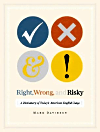
A Dictionary of Today's American English Usage

| Book of the Month | ||
 |
Right, Wrong, and Risky: A Dictionary of Today's American English Usage |  |
Publisher: Norton
Author: Mark Davidson
$16.00
ISBN 0393061191
American English is evolving very quickly, and even professional writers are sometimes uncertain which usages are correct. When newspaper reporters get it wrong, perhaps the reason is that they do not have this handy book by their side as they write. This book is a dictionary, but a very specialized one. It only lists words that are often misused - for example describing someone lying flat on his back as 'prone' is wrong. Someone lying flat on his face is prone. If you are flat on your back, you are supine. If this seems a bit advanced, more basic errors are corrected here as well. If you (as do many native speakers) say 'You should of done that' this book, politely but firmly reminds you that this should be 'You should have done that'. There are also tips on grammar, colloquialisms and punctuation, and discussion of whether it is OK to use 'okay' in formal English. As a final benefit, this book is not just well-written, but is as interesting and amusing as it is possible for a dictionary to be.
The book starts with two quotes. There is a negative one by Shaw 'The greatest problem with communication is the illusion that it has been accomplished'; and a positive by Hawthorne that true style should make words 'dissapear into thought'. This is followed by two short chapters of about six pages in all, explaining what this book is about ('Four questions about this book') and the author's approach to language ('Some words about words'). From there it is straight into the dictionary, beginning with a discussion of when to use 'a' or 'an'. Then the book works as does a dictionary right up to 'zoom';and a reminder that things can only zoom in an upward direction. (They plunge or plummet when going down.) This point leads to the book's major failing. There is no index, so if you want to find 'plummet',you can't find it in the book unless you know it is listed under 'zoom'. There is an excellent bibliography at the back, but this is nowhere near as useful as an index would have been. Some words or phrases are marked as 'risky' - which means that they are sometimes used in the manner described, but language purists might object. Often the author suggests a 'safe' alternative usage. Overall, about 2,000 to 3,000 words are discussed in this 570 page book. The advantage is that most difficult words are included, the disadvantage is that you might think twice before taking more than a kilogram of paper with you if you want to use the book outside the home or office. This book would be ideal as an eBook, but does not yet seem to be available as such.
Who is this book for? This book is so well written that native speakers might dip into the book for pleasure. Non-native speakers who want to make sure that their usage is up to date and correct will want this book close at hand so that they can consult it regularly. Students will find interesting extra information, such as the fact that 'ketchup' comes from the Malay word for a type of sauce. This information helps with vocabulary learning, and makes English more fun.
Verdict: Helps you write like a pro.
Assessment 7/10 (because of the missing index)